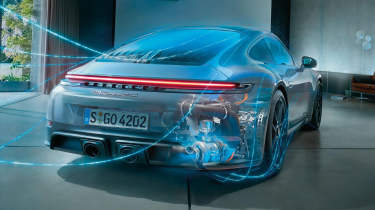Porsche patents cleaner, more powerful six-stroke engine design
The design is as much a two-times-three-stroke as it is a six-stroke, and has the potential to massively increase power and reduce emissions
Porsche has patented a revolutionary six-stroke internal combustion system. Contrast to all modern combustion engines that run the four-stroke Otto cycle that typically features one compression and ignition phase, Porsche’s system adds another.
The result is that in one cycle, the piston compresses the fuel/air mixture in the combustion chamber twice, rather than just the once, with two combustion events and therefore, two power strokes. On the second, the waste product of the first is being compressed again. The six-stroke cycle is more like two mini cycles of three, with intake, compression, power in one followed by compression, power and exhaust in the next.
It manages this with a crank that spins around a planetary gear while also rotating itself, meaning it doesn’t just rotate around a solid central point. Rather, there are two top dead-centre and two bottom dead-centre positions within the rotational annulus. That also means that the piston stroke and compression will differ across the two top dead-centre and bottom dead-centre states. Put simply, there isn't a set compression and stroke, as per a fixed-crank four-stroke engine.
The result is increased efficiency and most importantly, increased power, albeit with a bit of added complexity. With power coming every three strokes now instead of every four, it stands to reason there should be more of it. The combustion process should be cleaner with the second compression phase effectively ‘scavenging’ gases from the first combustion and recombusting them. Sort of how an exhaust gas recirculation system works, without the need to actually recirculate it. The thermal efficiency potential of a six-stroke is up to 50 per cent, compared to the 30 per cent that’s considered average for a four-stroke engine.
What could this mean for the way an engine feels? As above, power every three strokes instead of every four sounds good, but what does a six-stroke cycle mean for throttle response, how the engine will rev and indeed, how it will sound? We don’t know yet, but with the added complexity and vibrational potential, one has to wonder whether this technology will suit high-revving applications like a 992 Porsche 911 GT3.
As is always the case with patent filings, there’s no mention of production intent or indeed, any associated issues or drawbacks with the design. What’s clear and not to mention reassuring, though, is that Porsche has some of its brightest minds looking at how the combustion engine could evolve for a new era, in tandem its extensive work on developing and manufacturing eFuels and ramping up electrification.









